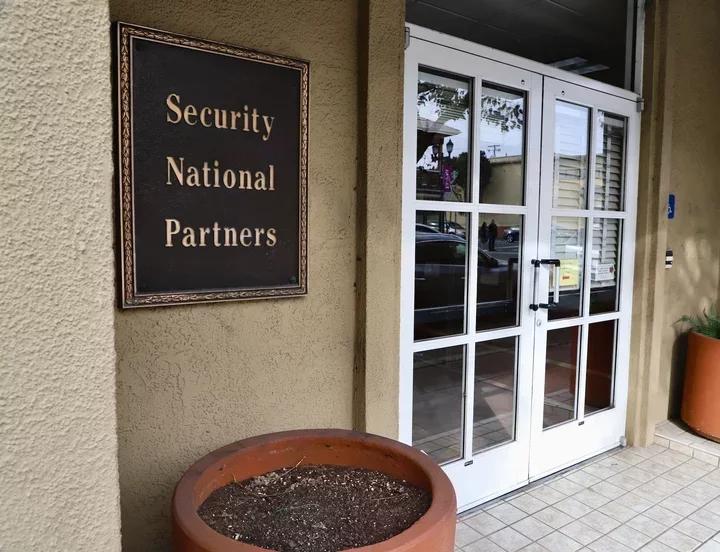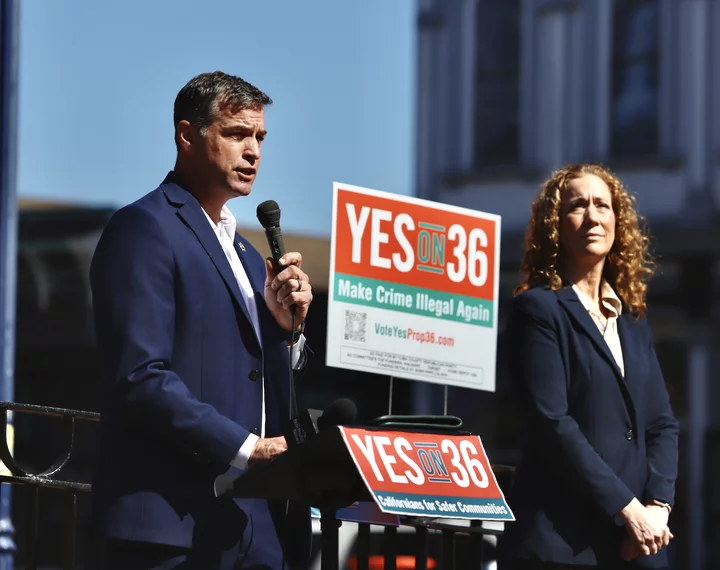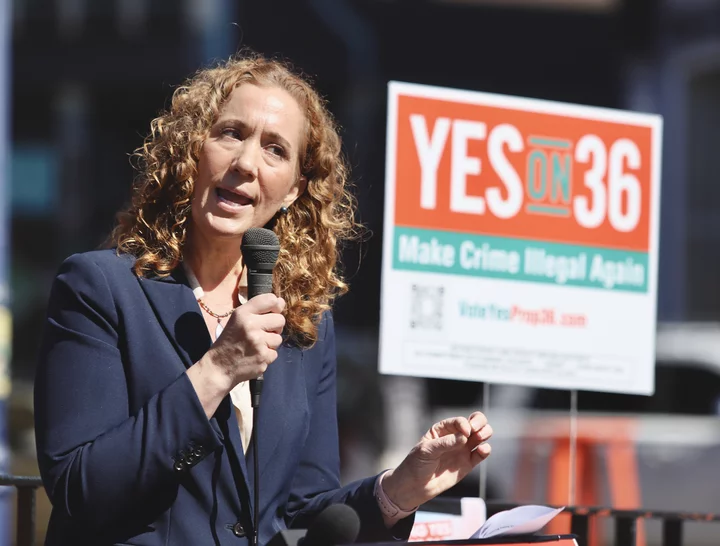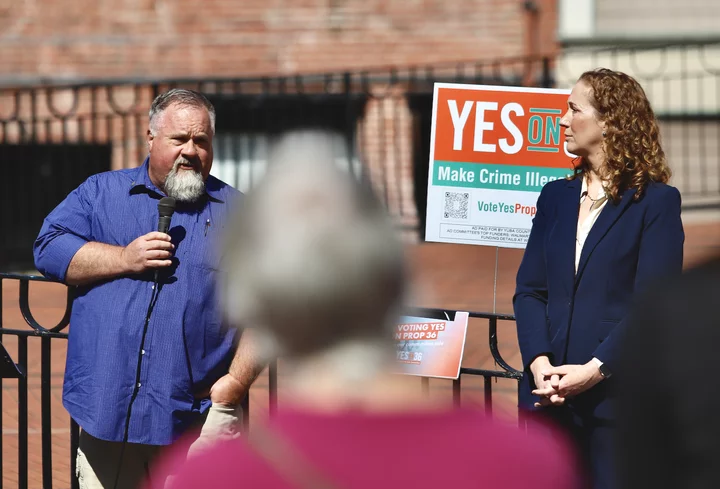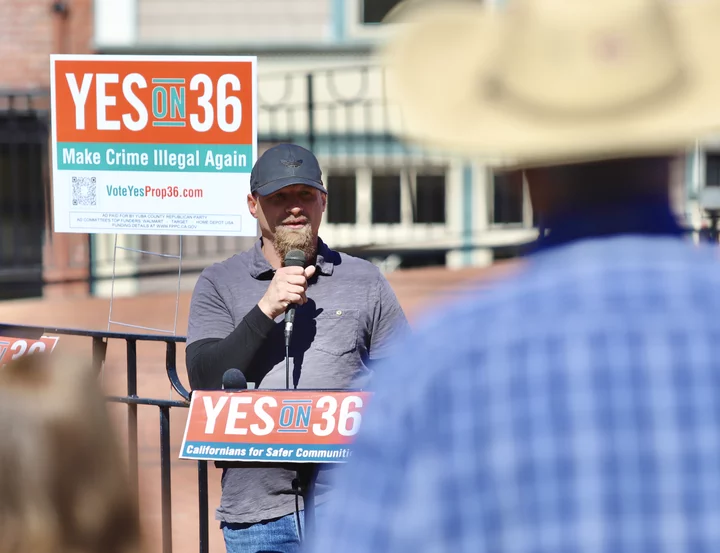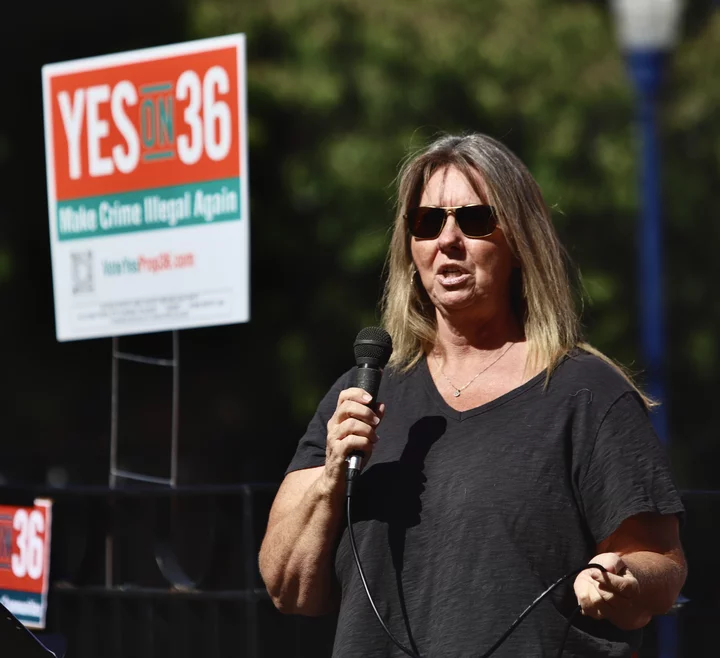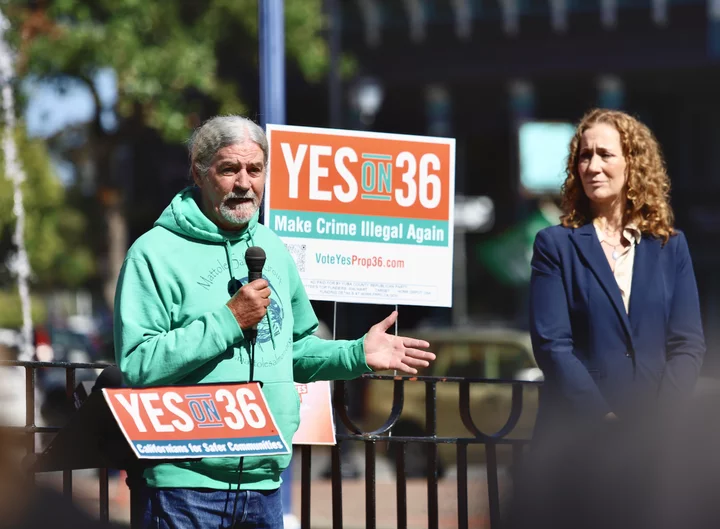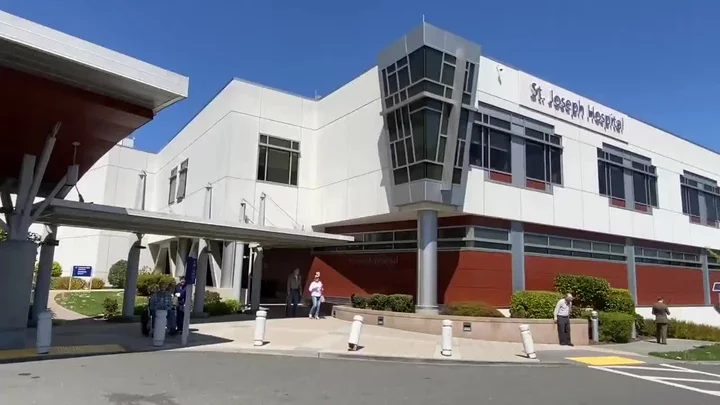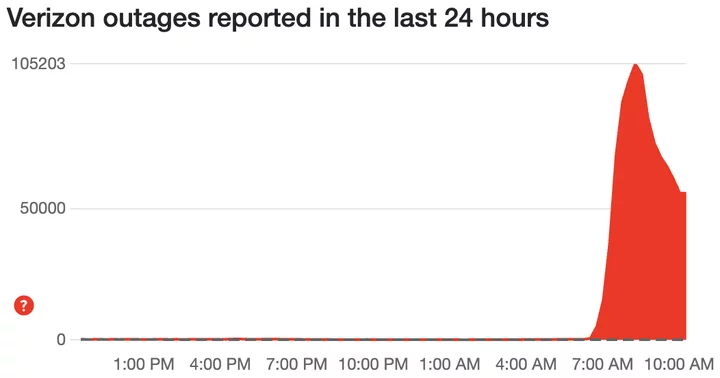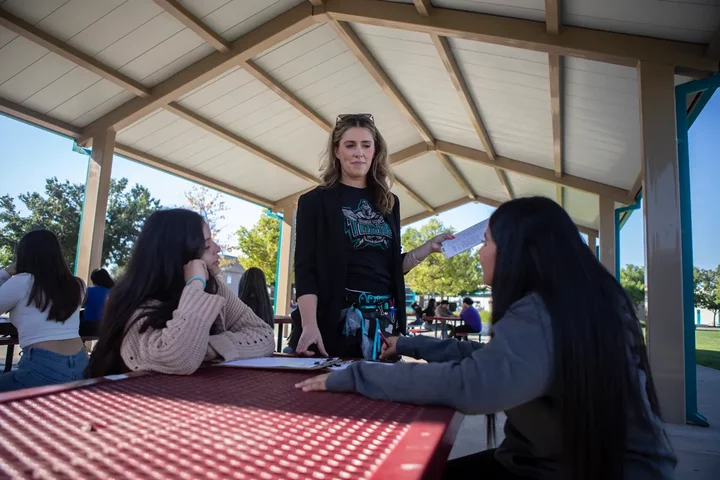Eureka Campaign Finance Roundup: Security National Passes $1.2M Spent on ‘Yes on F’; Carswell Leads in Fundraising Among Eureka Council Candidates
Ryan Burns / Monday, Sept. 30, 2024 @ 4:47 p.m. / Elections
Security National HQ on Fifth Street in Eureka. | File photo.
###
The latest batch of campaign finance disclosure forms were due to the City of Eureka this past Thursday, and we’ve got a roundup of all the campaign and candidate fundraising in the City of Eureka for this election season, including an eye-popping sum from one company in particular.
Here’s the rundown:
Yes on F, A Committee in Support of the Housing for All and Downtown Vitality Initiative, Sponsored by Security National Properties Holding Company, LLC:
On Saturday, Security National dumped another $94,333 into the Measure F campaign, which was already the most expensive ballot initiative in Eureka history. This latest donation brings the total raised for the so-called “Housing for All and Downtown Vitality Initiative” to $1,224,037. All but $600 of that sum has come directly from Security National. (Eureka accountant John B. Fullerton, who is working on the campaign, chipped in $100 last month and former Renner Petroleum owner Michael Lawrence Renner, who now lives in Las Vegas, donated $500 last year.)
Security National, of course, is the real estate loan servicing firm founded by semi-local tycoon Rob Arkley, whose fury over the city’s downtown development plans was expressed via shouted expletives, insulted-filled emails and threats of political and legal action.
Arkley also vowed to move his business headquarters out of city limits, and while he has yet to follow through on that particular threat, his company did provide startup funding for the group called Citizens for a Better Eureka, which filed four environmental lawsuits against the city. And last November, Security National paid $650,000 to buy the parking lot in front of City Hall and promptly put up barricades that prevent anyone from parking there. (That expense is not an official part of the campaign spending.)
As you’ve no doubt noticed by now, Security National has flooded the zone with advertising — including TV, radio, print, online and billboards — while spending hundreds of thousands on outside consultants.
No on Measure F: A Committee to Defend Eureka’s Housing
Through Sept. 21, the opponents of Measure F had raised a comparatively modest sum of $19,537, which represents less than 1.6 percent of the amount spent by Security National. The largest “No on F” campaign contributions came from the Central Labor Council of Humboldt and Del Norte Counties AFL-CIO C.O.P.E. ($2,500); AFSCME Local #1684 ($2,500); retired doctor Wendy Ring ($2,000); former Eureka Mayor Susan Seaman ($550); and Eureka scientist Dr. Dale Preston ($500).
Campaign treasurer James Kloor, who works as the director of finance at the Humboldt Area Foundation, loaned the campaign $1,950 through Sept. 21, and has already been reimbursed with campaign funds.
The “No on F” effort has spent $14,703 thus far, primarily on campaign literature and paraphernalia, including yard signs.
Lucky for Ward 4:
Thavisak “Lucky” Syphanthong, who’s running against incumbent Scott Bauer for Eureka’s Fourth Ward seat on the city council, raised $1,772.68 this reporting period, of which $1,672.68 (94 percent) was a loan to himself. (The other $100 was a donation from Eureka retiree Chuck Elsworth.
Syphanthong spent $391 on his campaign statement, $442.85 on a campaign kickoff event and $127.24 on meetings and events.
Scott Bauer For Fourth Ward Of Eureka City Council 2024:
In Bauer’s first campaign disclosure statement of this cycle he reported raising $1,363 through Sept. 21, and he’d spent just $127 of that amount. His largest donors include Eureka retiree Barry Douglas ($300), Eureka general contractor Jake Larson ($250) and three donors at $100 apiece, including Fourth District Humboldt County Supervisor Natalie Arroyo.
Kenny Carswell for Eureka City Council Ward 2 2024:
Carswell, who’s employed as a project manager for Security National, reported raising $6,465 through Sept. 21, including a loan to his own campaign in the amount of $1,253. His top donors include $500 contributions from Eureka accountant William McAuley, Eureka real estate appraiser Cynthia Olsen and Fortuna residents Steve and Heather Bryan, who own the 707 Bar on First Street. He had a number of other donations of between $100 and $300.
Carswell’s campaign reported spending $5,192, with expenditures for fundraising events, campaign paraphernalia, advertising and filing fees.
Kati Moulton for Eureka City Council, 2024:
Moulton, the incumbent councilmember is Eureka’s Second Ward, raised just $774 through Sept. 21 and spent $663 of that. The four donors who contributed at least $100 to her campaign include Dr. Preston and Catherine Sennott ($300); Eureka retiree Deborah Dukes ($100); former Humboldt County Supervisor Mark Lovelace ($100) and current Supervisor Arroyo ($100).
###
Mark it on your calendars: Election Day is Nov. 5 — just over five weeks off! If you’re not registered to vote, it’s not too late. Click this link to register online before October 21, or you can “conditionally” register and vote at your county elections office after the 15-day voter registration deadline.
BOOKED
Today: 7 felonies, 9 misdemeanors, 0 infractions
JUDGED
Humboldt County Superior Court Calendar: Yesterday
CHP REPORTS
Us199 / Us101 N Us199 N Con (HM office): Traffic Hazard
5600 Mm101 N Men 56.00 (HM office): Assist with Construction
ELSEWHERE
RHBB: Safeway Stores to Remain Open as Union Reaches Tentative Deal with Company
CBS Sacramento: Safeway workers in Northern, Central California set new midnight strike deadline
AP News: A man accused of stabbing 11 people at a Walmart is in Michigan authorities’ custody
OPB: Oregon puts the brakes on farm stand changes following public outcry
‘WE HAVE TO TAKE A STAND’: Law Enforcement, Businessfolk, Government Officials Push for Tougher-on-Crime Proposition 36 at Noontime Rally
Hank Sims / Monday, Sept. 30, 2024 @ 2:32 p.m. / Elections
Sheriff Billy Honsal and District Attorney Stacey Eads. Photos: Andrew Goff.
###
ELSEWHERE:
###
Today at noon at the Eureka Gazebo, Sheriff William Honsal and District Attorney Stacey Eads led a rally in support of Proposition 36, a measure on the Nov. 5 ballot that would enact stiffer penalties for some crimes.
In particular, it would partially repeal Proposition 47, a criminal justice reform initiative passed by the voters in 2014, by mandating that several misdemeanors related to drugs and theft be reclassified as felonies. It would also allow certain of those felonies to be addressed through treatment, rather than imprisonment.
Honsal, who opened the event, said that Proposition 36 would give law enforcement much-needed tools to turn people with addiction problems toward rehabilitation, while at the same time allowing officers to crack down harder on thievery — one of the ways addicts find money to pay for drugs.
“There really is no current incentive for individuals who are arrested for minor drug offenses to receive mandatory drug treatment,” Honsal said. “Individuals opt out of seeking treatment because there’s no accountability, and there’s no consequences. This must change, and with the passage of Prop. 36 this will change.”
Honsal and Eads were joined by Supervisors Rex Bohn, Michelle Bushnell and Steve Madrone. Several local police chiefs were in attendance. Kevin Jenkins, owner of McKinleyville Ace Hardware store, spoke about how brazen shoplifting is affecting his business, his employees and his customers. And Frank Falcone of Redwood Teen Challenge talked about how he escaped addiction with the help of the law.
District Attorney Stacey Eads.
District Attorney Eads gave the crowd a thorough overview of what laws Proposition 36 would overhaul, and told stories of cases here in Humboldt County where it would have been useful. She spoke of a major fentanyl dealer — a repeat offender — who could only be sentenced to a small amount of time in the local jail, along with a period of house arrest. She talked about a particular retail theft suspect who was arrested three days in a row on the same charge.
Prop. 36 would give her the tools to give those people serious time, she said.
“If you decide to vote no on Prop. 36, then you’re deciding that you’re okay with the status quo,” she said. “So, you’re okay with this individual repeatedly stealing from our businesses. You’re okay with hardened drug dealers coming to Humboldt County with large quantities of drugs to put out on our streets. You’re okay with a fentanyl dealer walking around with a loaded firearm. That’s what’s a no vote on Prop. 36 means.”
Kevin Jenkins.
Jenkins talked about the the rising incidence of theft he’s seen at his hardware store, telling about two particular cases he said occurred just within the last week. In one case, he said, a woman carefully stole just under $950 in new tools — the limit between a misdemeanor and a felony — and in another, a man stole a whole rack of pants. Because of the way the law is written write now, neither the police or prosecutors can do much to slow down such crimes, he said.
“That stuff will show up on Facebook Marketplace within a few days,” Jenkins said. “There’s a system, there’s an under-economy … So we’re all paying for it. We’re paying for it as a person that’s never touched drugs in their life. And I’ve come to the realization, the painful realization that the people that are doing the stealing, they’re not stealing because they enjoy it. They’re not stealing because they’re trying to provide a higher quality lifestyle for their family. They’re feeding their addiction.”
Frank Falcone.
Falcone, who described himself as a 20-year meth addict, talked about his path to recovery, which started with an overdue visit to a probation officer. That initial step, he said, put him on a path to treatment.
“I started taking responsibility and saying, hey, those are the choices that I made,” Falcone said. “And I think this Proposition 36 is really going to help to get the people help that they need. They need a program for a while, not just a 30 days or 60 days where they could just leave and get a free meal, but the right tools that they need to be successful in life.”
Supervisor Michelle Bushnell.
Like Jenkins, Supervisor Michelle Bushnell — owner of the Boot Leg in downtown Garberville — had stories to tell about retail theft, but she spent more of time talking about how addiction had touched her own family. Though he has several years clean, a close family member suffered from alcoholism, racking up five DUIs and nearly killing himself in a car crash before finally getting sober. All the time, she said, she begged law enforcement to take him in, so that he might have a chance to write a different future for himself.
“I beg people to please vote yes on Prop. 36,” she said. “Think about your future generations and the people that need help. Sometimes they’re not capable to ask for it.”
Steve Madrone.
“This revolving door issue, the way that works … we’ve got to put an end to that,” said Supervisor Steve Madrone, referring both to thieves of the type that Jenkins referred to and people with serious drug rap sheets. “It’s just crazy to have people in and out, in and out. And there’s no repercussions that seem to actually change that behavior.”
Madrone brought the pep to the rally.
“What are we votin’ on?” he asked. “Yes on what?”
“36!”
“36! That’s right! It’s gonna help us.”
Rex Bohn.
“I appreciate the sheriff, our district attorney and especially the chiefs that could be here today that are supporting [Prop. 36], because I’ll tell you what … if they say we need it, that’s who we call … to be safe,” said Supervisor Rex Bohn, chair of the Humboldt County Board of Supervisors. “So let’s give them the tools to do it.”
Attorney General Sues St. Joseph Hospital for Denying a Woman Emergency Abortion Care
Ryan Burns / Monday, Sept. 30, 2024 @ 11:41 a.m. / Health Care
California Attorney General Rob Bonta announces lawsuit against St. Joseph Hospital as Eureka chiropractor Anna Nusslock looks on. | Image via Bonta’s Twitter account.
###
UPDATE, 11:58 a.m.:
Shortly after this post was published, Bonta’s office issued the following press release, which includes links to the complaint and preliminary injunction:
SACRAMENTO — California Attorney General Rob Bonta today announced a lawsuit against Providence St. Joseph Hospital (Providence) in Eureka, California. In the lawsuit, filed in Humboldt County Superior Court, the Attorney General alleges Providence violated multiple California laws due to its refusal to provide emergency abortion care to people experiencing obstetric emergencies.
One particular patient, Anna Nusslock, had her water break when she was 15 weeks pregnant with twins on February 23, 2024. Despite the immediate threat to her life and health, and despite the fact her pregnancy was no longer viable, Providence refused to treat her. She had to travel to a small critical access hospital called Mad River, 12 miles away, where she was actively hemorrhaging by the time she was on the operating table. In addition to filing the complaint, the Attorney General is moving immediately for a preliminary injunction to ensure that patients like Anna will receive timely emergency healthcare services at Providence, including abortion care.
“California is the beacon of hope for so many Americans across this country trying to access abortion services since the Dobbs decision. It is damning that here in California, where abortion care is a constitutional right, we have a hospital implementing a policy that’s reminiscent of heartbeat laws in extremist red states,” said Attorney General Bonta.
“With today’s lawsuit, I want to make this clear for all Californians: abortion care is healthcare. You have the right to access timely and safe abortion services. At the California Department of Justice, we will use the full force of this office to hold accountable those who, like Providence, are breaking the law.”
In February 2024, Anna Nusslock was fifteen weeks pregnant with twins when she visited Providence in pain and severely bleeding after her water prematurely broke. At Providence, the doctor diagnosed Nusslock with Previable Premature Pre-labor Rupture of Membranes (Previable PPROM) and confirmed her twins would not survive. Her diagnosis also meant that without abortion care, she was at increased risk of permanent harm or death from infection and hemorrhage.
Nevertheless, Providence informed her that hospital policy prohibited them from providing this emergency care as long as one of her twins had a “detectable heartbeat.” Only once there was an immediate risk to Nusslock’s life—which is to say, a more immediate risk than she already faced—would the hospital give her the treatment she needed.
Instead of providing Nusslock emergency medical abortion care required by state law, Providence discharged her with instructions to drive to a small community hospital nearly 12 miles away. On the way out the door, Providence handed Nusslock a bucket and towels “in case something happens in the car.”Providence’s policy bars doctors from providing life-saving or stabilizing emergency treatment when doing so would terminate a pregnancy, even when the pregnancy is not viable. Not only does this violate California law, this policy discriminates against pregnant patients as the hospital chooses the decision for them.
Today’s complaint alleges Providence violated California’s Emergency Services Law (the state level analogue to the federal EMTALA statute), the Unruh Civil Rights Act, and the Unfair Competition Law.
Additionally, the Attorney General moved for a preliminary injunction, seeking a court order to guarantee that patients receive prompt emergency medical care including abortion care. This is especially critical because the hospital—Mad River Community Hospital—where Anna eventually received her abortion will be closing its labor and delivery (L&D) unit this October. In a month, Providence will be left as the only hospital with an L&D unit in all of Humboldt County. The next person in Anna’s situation will face an agonizing choice of risking a multi-hour drive to another hospital or waiting until they are close enough to death for Providence to intervene.
This lawsuit enforces the crucial right to emergency abortion care under California state law, while the scope of federal protections for such care under the Emergency Medical Treatment and Labor Act (EMTALA) remain uncertain.
Under EMTALA, every hospital in the United States that operates an emergency department and participates in Medicare is required to provide stabilizing treatment to all patients with an emergency medical condition. When the U.S. Supreme Court upended decades of legal precedent establishing a constitutional right to an abortion in Dobbs v. Jackson Women’s Health Organization, EMTALA should have provided a critical backstop, guaranteeing that no matter what state a pregnant patient was in, they would receive the emergency care, including abortion care, they needed. But this past summer in Idaho v. U.S., the U.S. Supreme Court declined to confirm that EMTALA requires hospitals to provide necessary abortion care to pregnant patients experiencing access medical emergencies irrespective of any conflicting state law. With EMTALA in limbo, states like California have to rely on their own state laws to protect pregnant patients.
California Attorney General Bonta remains committed to ensuring that California continues to be a safe haven for those seeking essential reproductive healthcare including abortion care. For more on his actions, and for key resources to assist you in obtaining reproductive healthcare, visit https://oag.ca.gov/reprorights.
If you are looking for information specific to abortions, the California Abortion Access website provides a safe space to find resources and guidance. The privacy of those who visit this website is protected, and their information is not saved or tracked.
California law requires hospitals to provide emergency abortion care. Click here to learn more.
If you were denied an abortion you needed in a medical emergency, or if you were denied any other emergency medical care, you can contact abortion.access@doj.ca.gov.
A copy of today’s filed complaint and preliminary injunction can be found here and here.
###
Original post:
St. Joseph Hospital in Eureka. | File photo.
###
California Attorney General Rob Bonta today filed a lawsuit against Providence-St. Joseph Health Northern California, alleging that Eureka’s St. Joseph Hospital denied emergency abortion care to a woman who arrived in pain and severely bleeding after her water broke just 15 weeks into pregnancy.
Eureka chiropractor Anna Nusslock was pregnant with twins when she arrived at the hospital this past February.
From the New York Times:
Doctors said one of the twins she was carrying would not survive and the other had almost no chance, according to medical records. They said that if the pregnancy was not terminated, she could face infection, hemorrhaging and threats to her future fertility.
But Providence, a not-for-profit Catholic health care system, has a policy that “bars doctors from providing life-saving or stabilizing emergency treatment when doing so would terminate a pregnancy, even when the pregnancy is not viable,” Bonta’s office told the San Francisco Chronicle in a statement. “Not only does this violate California law, this policy discriminates against pregnant patients as the hospital chooses the decision for them.”
Nusslock was discharged and eventually received an abortion at Mad River Community Hospital. When St. Joseph sent her away she was provided with “a bucket and towels ‘in case something happens in the car,’” Bonta’s office said.
Mad River Community Hospital’s birthing center is scheduled to close at the end of this week, leaving St. Joseph Hospital as the only childbirth center in Humboldt County.
The state’s suit against Providence alleges that St. Joseph violated California’s Emergency Services Law, the Unruh Civil Rights Act and the Unfair Competition Law.
Bonta announced the lawsuit in a press conference this morning.
NOW: CA Attorney General @AGRobBonta @RobBonta announces a lawsuit against Providence St. Joseph Hospital (Providence) in Eureka. In the lawsuit, Bonta alleges the hospital violated multiple California laws due to its refusal to provide abortion care to people experiencing… pic.twitter.com/dnGEBqpJ3u
— Eytan Wallace (@EytanWallace) September 30, 2024
This story is breaking. We will update when we have more information.
No, You are Not Alone With Your Verizon Woes
Andrew Goff / Monday, Sept. 30, 2024 @ 10:32 a.m. / Technology
Chart of user-reported Verizon outages from DownDetector
Many Humboldt Verizon users are experiencing connection issues this morning due to a large outage that seems to be impacting vast swaths of the country. Fear not. Verizon sees you, boo.
“We are aware of an issue impacting service for some customers,” Verizon announced through its social media channels about an hour ago. “Our engineers are engaged and we are working quickly to identify and solve the issue.”
For whatever reason, it seems like not all Verizon users are affected by the service disruption. If you’d like to compare notes, plenty of folks are currently commiserating on the LoCO Facebook page. Hang tight, crew.
Sheriff’s Office Seeks Public’s Help in Solving Case of a Hoopa Woman Who Went Missing 33 Years Ago
LoCO Staff / Monday, Sept. 30, 2024 @ 10:17 a.m. / Crime
Andrea “Chic” White posing for a family photo with her children before being reported missing in July 1991 | Photo provided to the Sheriff’s Office by White’s family.
###
From the Humboldt County Sheriff’s Office:
The Humboldt County Sheriff’s Office is asking for the public’s help in a missing persons case from 1991.
On July 31, 1991, Andrea Jerri White (also known as “Chic”) traveled from the Hoopa area to Eureka to complete errands. When she did not return home that day, her family reported her missing to the Humboldt County Sheriff’s Office.
Early in the investigation, detectives were able to locate a witness who gave White a ride from Guintoli Ln., Arcata, to the Blue Lake exit on Highway 299, from which point she had reportedly planned to hitch hike the rest of the way home. This witness was the last known person to have seen White, and there have been no other leads located to indicate her method of travel from Eureka to Arcata. White was never seen again and has made no contact with family.
White was 22 years old at the time of her disappearance. She is a Native American female, 5 feet tall, weighs about 110-115 pounds with brown shoulder-length hair and brown eyes. She was possibly wearing Levis pants, a sleeveless white shirt and a black leather jacket, and carrying a black duffel bag with white trim.
The Sheriff’s Office conducted several searches along Highway 299 from Blue Lake to Willow Creek. ATVs, ground searchers and a helicopter were utilized. White left behind several small children at the time of her disappearance.
The Sheriff’s Office believes White’s disappearance is a homicide and asks anyone with information to contact Investigator Mike Fridley at 707-441-3024.
As Tonight’s Deadline Nears, Here Are the Most Notable Bills That Gov. Newsom Signed and Vetoed Over the Weekend
Lynn La / Monday, Sept. 30, 2024 @ 7 a.m. / Sacramento
Gov. Gavin Newsom has until midnight tonight to act on the fewer than 40 bills remaining on his desk. As of Sunday, the proportion of bills that Newsom has vetoed since the Legislature adjourned Aug. 31 is about 19% (or 181 of nearly 960 measures).
Some notable bills the governor spiked over the weekend:
- Artificial intelligence: A high-profile and controversial bill that would have regulated AI technology by requiring companies to test their AI models for societal harm. In his veto message, Newsom said the bill risks “curtailing the very innovation that fuels advancement in favor of the public good.” The proposal was backed by some prominent tech researchers and Hollywood, and fiercely opposed by Big Tech.
- Undocumented immigrants: After vetoing two bills earlier this month that would have expanded homebuyer aid to undocumented immigrants and enabled undocumented students to work on college campuses, the governor vetoed another that would have directed the state to explore extending unemployment benefits to undocumented workers.
- Farmworkers: A bill to make it easier for farmworkers to file for workers’ compensation for heat illness. Newsom said the state’s workplace safety agency, Cal/OSHA, should enforce heat safety rules — not the workers’ compensation system.
- Public health: A number of bills related to public health and health care, including ones to regulate pharmacy middlemen; authorize the state Attorney General to oversee private equity takeovers of doctors’ offices and related businesses; speed up the licensing process for gender-affirming healthcare providers; and allow some community colleges to issue bachelor’s degrees in nursing.
- Media access: A bill to permit news media to interview incarcerated people in person. Newsom said the bill could elevate “the celebrity status” of certain prisoners, “which could glorify their actions and hurt victims and their families.”
Gov. Newsom also signed these bills:
- Anti-union meetings: Saying that “California has a rich history of standing up for workers’ rights,” Newsom signed a bill prohibiting employers from forcing workers to attend anti-union meetings.
- Domestic violence: A measure to give the families of domestic violence victims the right to review death investigations they deem suspicious.
- Book bans: A bill requiring public libraries in to establish a clear policy for choosing books, but also prohibit banning material solely because it deals with race or sexuality.
- Voter IDs: A measure to ban local governments from requiring voters to present identification to vote.
- Health care: A handful of bills addressing health care, including one that requires some insurers to cover in vitro fertilization.
- Food and alcohol: Several bills, including one that bans six common synthetic food dyes in food sold at schools; requires tortilla makers to add folic acid to help pregnant women; and permits local governments to create “entertainment zones” where people can drink outside.
And a mixed record on places to give birth: Newsom approved one bill and vetoed another that were meant to inform the public about hospitals’ closing their maternity wards. He signed one that requires hospitals to give four months of notice when closing their maternity wards, giving the community time to plan, and vetoed another that would have required hospitals to notify the state if they are at risk of losing maternity services. These bills follow a CalMatters investigation into the state’s maternity-care deserts.
###
CalMatters.org is a nonprofit, nonpartisan media venture explaining California policies and politics.
Use It or Lose It: California Schools Race to Spend the Last of Their Pandemic Funds
Carolyn Jones / Monday, Sept. 30, 2024 @ 7 a.m. / Sacramento
Instructor Alana Woodin teaches her ninth-grade class in the student outdoor learning pavilion at Orange Cove High School in Orange Cove on Sept. 23, 2024. Kings Canyon Unified School District used funding from the Elementary and Secondary School Emergency Relief Fund to build shaded areas so classes can be held outside. Photo by Larry Valenzuela, CalMatters/CatchLight Local
Despite the dire forecast for education funding, some California schools may soon find themselves doing something counter-intuitive: returning money to the government.
The deadline for committing federal COVID-19 relief money is Sept. 30, and schools that haven’t planned to spend their money by then or received an extension must send it back to the U.S. Department of Education.
“It’s not a hard fiscal cliff, but it’s a big deal because it’s the last time districts can make decisions about how to spend this money,” said Bella DiMarco, a policy analyst for FutureEd, an education think tank at Georgetown University’s McCourt School of Public Policy. “Some districts have been planning for this from Day One, but others are going to be scrambling at the last minute.”
Dozens of California school districts still hadn’t spent the majority of their Elementary and Secondary School Emergency Relief Act money as of Aug. 28, according to a database compiled by Georgetown’s Edunomics Laboratory. In some cases, districts risked leaving millions of dollars on the table.
Overall, California schools hadn’t yet spent $1.8 billion of the $13.5 billion they were allotted when the final – and largest – of the pandemic relief grants rolled out in 2021.
School districts contacted by CalMatters said they intend to spend the money before the deadline, or had already committed it to vendors — such as organizations providing after-school programs — but there was a lag in the paperwork.
The pandemic relief funds were an unprecedented windfall for schools, intended to help them reopen safely for in-person instruction and help students who fell behind during remote learning. In all, the federal government gave $190 billion to schools through several waves of COVID relief grants.
By mid-September, most of California’s largest districts — including Los Angeles Unified, San Diego Unified, San Francisco Unified and Elk Grove Unified — had spent close to all their funds. A few, such as Fresno Unified, had unspent millions but did not respond to requests for an explanation.
Long Beach Unified, with 64,000 students, still had not spent $66 million — roughly 30% — of its $212 million allotment. The district plans to spend it all by the deadline on needs including playground equipment ($11 million) and classroom modernization ($14 million), said spokesperson Elvia Cano.
“While we have carefully paced our spending to maximize impact, we remain on track to allocate the remaining resources before the deadline,” Cano said.

Students during class at Lake Marie Elementary School in Whittier on Nov. 17, 2022. Photo by Lauren Justice for CalMatters
The end of pandemic relief grants comes at a precarious time for schools. While Gov. Gavin Newsom largely spared K-12 schools from cuts in his budget, the future could be grim as enrollment continues to decline, absenteeism remains high and the economy remains uncertain. Los Angeles Unified, for example, has seen its enrollment drop by 20% over the past decade, while absenteeism was higher than 30% last year. Because California funds its schools based on the number of students who show up every day, those empty seats mean the district receives millions less from the state.
School districts relied on their pandemic relief grants to pay for one-time investments they might not have been able to afford otherwise, like new heating, air conditioning and ventilation systems. They also spent the money on tutoring, after-school programs and mental health services to help students catch up academically and regain social-emotional skills. And some districts used the money to hire permanent staff or raise teacher salaries, which puts them in a vulnerable position as grant funding expires.
“Even if you’re a district that didn’t get a lot of (pandemic relief) money, you might have some tough budget decisions ahead,” said Julien Lafortune, a researcher at the Public Policy Institute of California who studies school funding.
School districts have known for almost four years that the money would be ending, and should not be blindsided by the cut-off, said Rebecca Thiess, who manages fiscal research at the Pew Charitable Trusts. They should have evaluated their spending to see what worked, what didn’t, and how they’d fund programs going forward.
“Schools received a lot of funding, which provided an opportunity for a lot of new programs and investments,” she said. “But they should have approached this opportunity mindfully so they’re not in a difficult position when the money runs out.”
Pandemic relief money wasn’t quite no-strings-attached, which is one reason for some districts’ slow spending, said Tatia Davenport, chief executive of the California Association of School Business Officials. The guidelines and reporting requirements were complicated, which was a big strain on districts with small administrative staffs, she said. Those districts also struggled to launch new programs because staff were already overburdened.
Davenport’s group is advising districts with surplus relief money to look back over recent expenses and see if anything can be paid for with pandemic grant money.
Ocean View School District, a TK-8 district in Huntington Beach in Orange County, used some of its relief money to lower class sizes. At first, the plan was to have fewer people in each classroom so students could return safely — and sooner — for in-person instruction. The lower student-to-teacher ratio was also intended to help boost student mental health and teacher morale.
The idea proved so popular that the district kept the smaller class sizes even after the threat of COVID-19 waned.
“Who doesn’t like smaller class sizes? Teachers loved it, students loved it, families loved it,” said Julianne Hoefer, interim superintendent. “It allowed us to build connections with students, nurture relationships, help students make up for learning gaps.”
The district also used relief grants to start a five-week summer program that included academic tutoring as well as games, field trips and other fun activities to boost student engagement. Students also got two meals a day.


First: District School Nurse Sofia Felix checks student Audrey Hernandez’s vitals in the nurse’s office at Sheridan Elementary School. Last: A ninth-grade class goes over their lesson in the student outdoor learning pavilion at Orange Cove High School in Orange Cove on Sept. 23, 2024. Photos by Larry Valenzuela, CalMatters/CatchLight Local
The program was “immensely popular” with families, more than half of whom are low income.
But with pandemic grants ending, the district now has to find a way to continue paying for the initiatives. It recently laid off 16 staff members, its first layoffs in recent memory.
“We have to figure out how to keep these programs,” Hoefer said. “So far, one-time money keeps showing up but we’d like to find a permanent funding stream.”
In Kings Canyon Unified, southeast of Fresno, the district has avoided layoffs because it spent most of its relief money on infrastructure improvements. The district hired a slew of temporary employees — counselors, health aides and teachers — but was able to find permanent funding to keep most of them on staff.
“We knew we had to be really smart about how we use this money, because we’ll never see this kind of funding again,” said Jose Guzman, assistant superintendent. “Our priority was to make kids safe, but also to make these investments sustainable.”
Using its pandemic grant money, the district built nine health centers, with nurses, separate entrances and bathrooms for sick students. The centers helped keep students and staff safe during the pandemic and beyond.
Among the district’s most popular projects were outdoor classrooms, dubbed “learning pavilions,” at five school campuses. Initially the pavilions were for COVID-19 safety, but students and teachers liked them so much they’re still used regularly. Not only do they reduce exposure to communicable diseases, Guzman said, but they boost mental health, as well.
“Our goal was to make our kids safe and happy, and this is what we did,” Guzman said. “Our community truly appreciates that.”
###
CalMatters.org is a nonprofit, nonpartisan media venture explaining California policies and politics.

